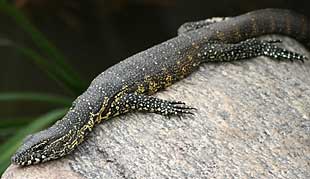Contact Details: Scotch Macaskill, Dirt Road Traders, Currys Post Road, Howick, KwaZulu-Natal, South Africa. Tel: +27 (0)82 578 2329. Privacy: Your privacy is guaranteed. See our Privacy Policy for more. This site accepts advertising and other forms of compensation - see Disclosure and Advertising for details. Site updated: 2022. Copyright © 2002 - 2022 Scotch Macaskill

| ||||||||||
|
||||||||||
|
SEE ALL
|
Monitor Lizards - Fearsome Predators on Land and Waterby Roddy SmithIf, like me, you are routinely tricked by changes in classification of birds and trees, brace yourself: the whole class of reptiles may well be in for a shake-up. There is no identifying characteristic which is typical of all reptiles and nothing else, in the way that all birds and only birds have feathers, and modern research has revealed new information about evolutionary relationships. The various groups traditionally lumped together as reptiles are believed to have a common ancestor, but they share it with birds, which are considered a different class. Crocodiles are more closely related to birds than to other reptiles, and it is now known that snakes and amphisbaenians are merely unusual lizards, rather than separate from them. Monitors, agamas and chameleons are more closely related to snakes than to other lizards; they are all believed to fall into the "venom clade" because, although they do not have fangs which can inject venom, they do have salivary glands that produce toxic proteins. Monitor lizards (or leguaans, although in South Africa we commonly use the Afrikaans name, "likkewaan") are fascinating but neglected animals, possibly because only an enthusiast would find them attractive.
This family has 59 species worldwide in a single genus (Varanus), including the fearsome Komodo Dragon. The two species in southern Africa are the Nile Monitor or Water Leguaan (Varanus niloticus - Africa's largest lizard) and the Rock Monitor or Tree Leguaan (Varanus albigularis). (In places like Zimbabwe there are occasional sightings of Election Monitors - these are not strictly lizards and their impact on their environment is so negligible they might as well be extinct.) The Nile monitor may possibly reach 2m, 60% of which would be tail, but this would be exceptional. Rock monitors are slightly shorter and bulkier, with tails slightly longer than the body.
Monitors are fearsome predators, hunting on and under the ground, in trees and (in the case of the Nile monitor) in the water. They differ from snakes in having movable eyelids and external ears, but they do have forked, snake-like tongues which they use in conjunction with the Jacobson's organ, a fluid-filled bi-lobed sensory organ in the roof of the mouth. The twin ends of the tongue collect odour particles from the air and then deliver them to the corresponding receptors of the Jacobson's organ, which can detect differences in strength on each tongue tip and from this gauge the direction of the scent, allowing the monitor to follow scent trails. They will eat practically anything: insects, reptiles, frogs, small mammals up to the size of domestic cats, birds and eggs, carrion and rubbish. Water monitors also catch fish and are among the most important predators of crocodile eggs. They have been observed using teamwork for this; one distracts the mother crocodile while others rush in to dig up the nest. Their short powerful legs are armed with strong claws which they use both for digging and climbing; I have seen one emerging with a chick from a bee-eater's nest in a vertical bank which would be inaccessible to snakes. Water monitors are excellent swimmers, folding their legs in and using their tails like crocodiles, and can stay underwater for well over half an hour. They can run astonishingly fast over a short distance, and invariably head for water when disturbed. 
Water monitor lying on a rock, Kruger Park, S.Africa They are often found up trees and will hurl themselves into the water from considerable heights; this has caused a certain amount of consternation on canoe trips when one has landed next to, and on one memorable occasion actually in, a canoe. Rock monitors are generally found further from water and are more likely to hold their ground when disturbed, hissing and swishing their tails, or in extreme cases shamming death. Both species will defend themselves if necessary by biting, scratching and lashing their powerful tails; these last can deliver a stinging blow but can not, as I was brought up to believe, break your leg. They do however have very powerful jaws and will hold on like a bull terrier. I know someone who rashly prodded one with his foot; it latched onto the toe of his velskoen and he eventually had to abandon the shoe as the only alternative was to kill the leguaan. A mature female can produce clutches of eggs weighing almost as much as she does - about 10-40 in rock monitors and 40-60 in water monitors. Reports of incubation periods vary widely and seem also to depend on temperature. Rock monitors lay their eggs in burrows, but the cunning water monitors usually use a hole dug in a live termite mound. The industrious termites immediately close the hole and the eggs are thus left in a secure temperature-controlled incubator, with termites for the ungrateful hatchlings to eat when they emerge. Roddy Smith is a wildlife conservationist and safari guide based at Mwambashi River Lodge in the Lower Zambezi National Park, Zambia. Return to Wildlife Articles |
|||||||||
|
|
||||||||||
